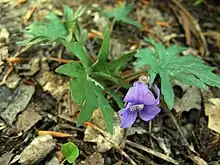| Viola subsinuata | |
|---|---|
 | |
| Scientific classification | |
| Kingdom: | Plantae |
| Clade: | Tracheophytes |
| Clade: | Angiosperms |
| Clade: | Eudicots |
| Clade: | Rosids |
| Order: | Malpighiales |
| Family: | Violaceae |
| Genus: | Viola |
| Species: | V. subsinuata |
| Binomial name | |
| Viola subsinuata | |
Viola subsinuata, commonly called the early blue violet,[1] is a species of flowering plant in the violet family (Violaceae). It is native to eastern North America, where it is primarily found in the Appalachian Mountains and Great Lakes area. Its natural habitat is in loamy forests, often over mafic or calcareous substrates.[2]
Viola subsinuata is a perennial that produces purple flowers in the spring. It is superficially similar to Viola palmata, and it can be distinguished by its earliest flowering leaves being divided and similar to later leaves (unlike V. palmata, which has undivided early leaves and divided later leaves).[3]
This species has a complicated taxonomic history, including much nomenclatural confusion and misidentification. The exact geographic boundaries of this species is poorly understood. A recent study indicates that it likely includes cryptic taxa.[2]
References
- ↑ Viola subsinuata at New England Wildflower Society
- 1 2 A Systematic Revision of the Viola pedatifida Group and Evidence for the Recognition of Viola virginiana, a New Narrow Endemic of the Virginia Shale Barrens, by Bethany Zumwalde. 2015
- ↑ Viola subsinutata Flora of North America